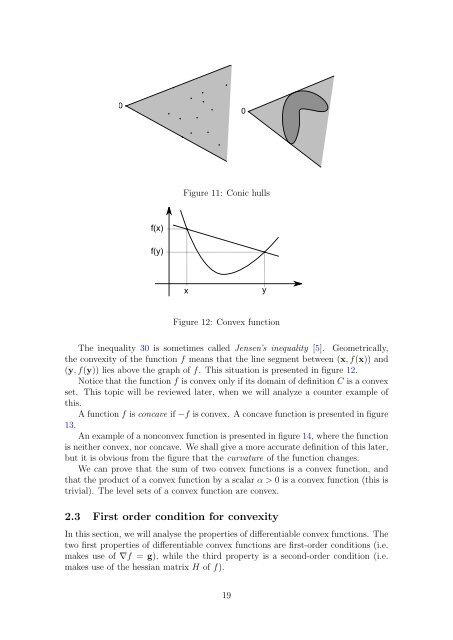Introduction to Unconstrained Optimization - Scilab
Introduction to Unconstrained Optimization - Scilab
Introduction to Unconstrained Optimization - Scilab
You also want an ePaper? Increase the reach of your titles
YUMPU automatically turns print PDFs into web optimized ePapers that Google loves.
0<br />
0<br />
Figure 11: Conic hulls<br />
f(x)<br />
f(y)<br />
x<br />
y<br />
Figure 12: Convex function<br />
The inequality 30 is sometimes called Jensen’s inequality [5]. Geometrically,<br />
the convexity of the function f means that the line segment between (x, f(x)) and<br />
(y, f(y)) lies above the graph of f. This situation is presented in figure 12.<br />
Notice that the function f is convex only if its domain of definition C is a convex<br />
set. This <strong>to</strong>pic will be reviewed later, when we will analyze a counter example of<br />
this.<br />
A function f is concave if −f is convex. A concave function is presented in figure<br />
13.<br />
An example of a nonconvex function is presented in figure 14, where the function<br />
is neither convex, nor concave. We shall give a more accurate definition of this later,<br />
but it is obvious from the figure that the curvature of the function changes.<br />
We can prove that the sum of two convex functions is a convex function, and<br />
that the product of a convex function by a scalar α > 0 is a convex function (this is<br />
trivial). The level sets of a convex function are convex.<br />
2.3 First order condition for convexity<br />
In this section, we will analyse the properties of differentiable convex functions. The<br />
two first properties of differentiable convex functions are first-order conditions (i.e.<br />
makes use of ∇f = g), while the third property is a second-order condition (i.e.<br />
makes use of the hessian matrix H of f).<br />
19

















